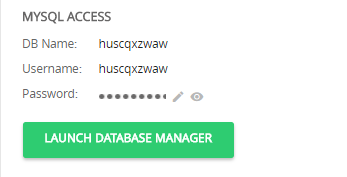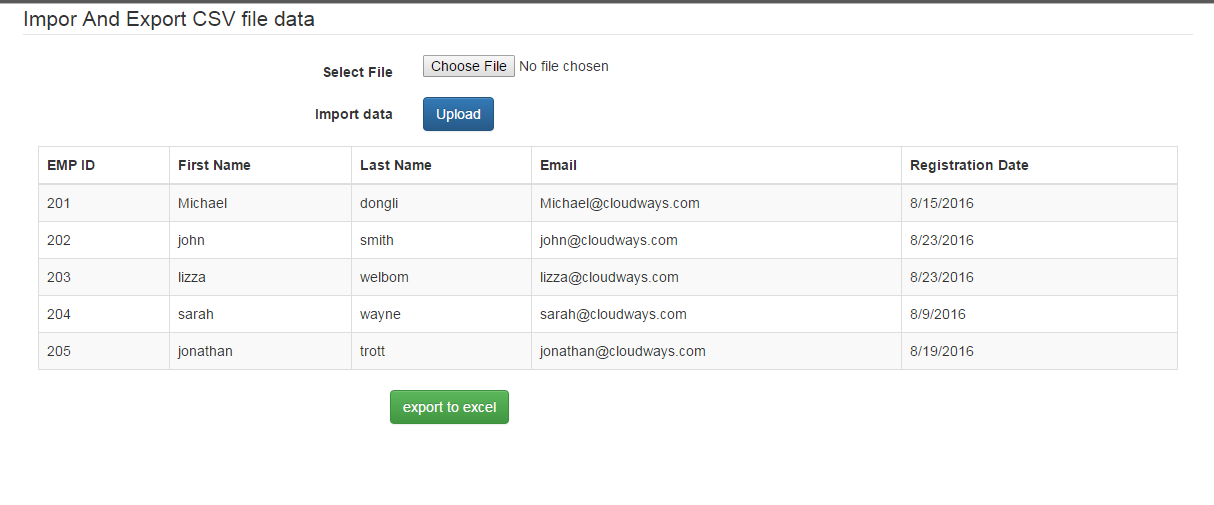
PHP 广泛用于构建从网络应用程序到企业级应用程序的各种产品。高效 PHP 代码的关键在于遵循正确的工作流程并实现流程自动化。其结果是代码质量高、无错误。
在几乎所有的 PHP 应用程序中,数据都是在应用程序的各个组件之间存储、访问和交换的。为确保数据交换和访问顺利进行且不出现任何问题,开发团队必须确保数据库和数据转储采用正确的格式。
在 PHP 开发中,将数据导入和导出数据库是一个非常常见的程序。另一项重要工作是备份和转移数据库。
在本文中,我将介绍如何从 mysql 数据表中导出 csv 文件。
在MySQL中创建数据库
本教程的第一步是创建 MySQL 数据库。部分服务器提供商在其平台中提供了自定义的 mysql 管理器,其中包含一个应用程序数据库,因此您可以通过运行 SQL 查询来创建表格。使用以下 SQL 查询在数据库中创建表格 `employeeinfo`.
CREATE TABLE employeeinfo( emp_id VARCHAR(50) UNSIGNED PRIMARY KEY, firstname VARCHAR(30) NOT NULL, lastname VARCHAR(30) NOT NULL, email VARCHAR(50), reg_date VARCHAR(50) )

这将在数据库中创建一个新表 `employeeinfo`。我将使用该表插入 CSV 文件中的数据。
在PHP中创建MySql连接
为导入和导出 MySql 数据库,将创建一个单独的文件 `config.php`。添加以下代码,并将数据库凭据替换为您的数据库凭据。您可以在应用程序访问详情(或者Mysql服务器详情)中找到您的数据库凭据:

<?php
function getdb(){
$servername = "localhost";
$username = "huscqxzwaw";
$password = "2WWKxxxxHr";
$db = "huscqxzwaw";
try {
$conn = mysqli_connect($servername, $username, $password, $db);
//echo "Connected successfully";
}
catch(exception $e)
{
echo "Connection failed: " . $e->getMessage();
}
return $conn;
}
?>
如何使用PHP将CSV导入MySQL?
创建数据库后,我们接下来需要一个可以上传 CSV 文件的 HTML 文件。让我们按照简单的步骤开始吧。
第 1 步:创建数据库和表
首先,需要在 MySQL 中创建一个数据库和一个表,用于存储 CSV 数据。下面是一个创建名为 employeeinfo 的表的 SQL 查询示例:
CREATE TABLE employeeinfo (
emp_id INT(11) NOT NULL,
firstname VARCHAR(255) NOT NULL,
lastname VARCHAR(255) NOT NULL,
email VARCHAR(255) NOT NULL,
reg_date DATE NOT NULL,
PRIMARY KEY (emp_id)
);
第 2 步:设计导入表单
现在,我们需要创建一个 HTML 表单来上传 CSV 文件。该表单将允许用户从自己的电脑中选择 CSV 文件并将其上传到服务器。
<form action="index.php" method="post" enctype="multipart/form-data">
<input type="file" name="file" accept=".csv">
<button type="submit" name="Import">Import CSV</button>
</form>
第 3 步:处理文件上传和验证
在 PHP 脚本中处理文件上传,并验证上传的文件是否为 CSV 文件。
if (isset($_POST["Import"])) {
$filename = $_FILES["file"]["tmp_name"];
// Check if the file is a CSV file
if (pathinfo($_FILES["file"]["name"], PATHINFO_EXTENSION) != "csv") {
echo "Please upload a CSV file.";
exit;
}
// Proceed with importing the CSV file
importCSV($filename);
}
Step 4:将 CSV 数据导入 MySQL
创建一个名为 importCSV() 的函数来处理 CSV 导入。该函数将读取 CSV 文件,并使用准备语句将数据插入 MySQL 数据库。
functions.php(导入部分)以下是如何安全地实现 importCSV() 函数:
function importCSV($filename) {
// Get a secure database connection
$conn = getConnection(); // Ensure this function returns a secure connection
// Open the CSV file
$file = fopen($filename, "r");
// Skip the header row (if it exists)
fgetcsv($file, 10000, ","); // Adjust delimiter if needed
// Prepare the SQL query
$sql = "INSERT INTO employeeinfo (emp_id, firstname, lastname, email, reg_date) VALUES (?, ?, ?, ?, ?)";
$stmt = $conn->prepare($sql);
if ($stmt === false) {
die("Error preparing statement: " . $conn->error); // Handle prepare error
}
// Bind parameters
$stmt->bind_param("sssss", $emp_id, $firstname, $lastname, $email, $reg_date);
while (($getData = fgetcsv($file, 10000, ",")) !== FALSE) {
// Validate data (example validation)
if (count($getData) != 5) {
error_log("Invalid CSV row: " . implode(",", $getData));
continue; // Skip to the next row
}
// Assign values
$emp_id = $getData[0];
$firstname = $getData[1];
$lastname = $getData[2];
$email = $getData[3];
$reg_date = $getData[4];
// Execute the query
if (!$stmt->execute()) {
error_log("Error inserting row: " . $stmt->error);
}
}
// Close the statement and connection
$stmt->close();
fclose($file);
$conn->close();
echo "<script type=\"text/javascript\">
alert(\"CSV File has been successfully Imported.\");
window.location = \"index.php\"
</script>";
}
// Example of a secure getConnection() function
function getConnection(): mysqli
{
$servername = $_ENV["DB_HOST"] ?? "localhost"; // Default to localhost if not set
$username = $_ENV["DB_USER"] ?? "your_db_user"; // Provide reasonable defaults
$password = $_ENV["DB_PASSWORD"] ?? "your_db_password";
$dbname = $_ENV["DB_NAME"] ?? "your_db_name";
try {
$conn = new mysqli($servername, $username, $password, $dbname);
if ($conn->connect_error) {
throw new Exception("Connection failed: " . $conn->connect_error);
}
return $conn;
} catch (Exception $e) {
error_log("Database connection error: " . $e->getMessage()); // Log the error
die("Failed to connect to the database. Check your configuration."); // Fatal error, stop execution
}
}
替代方案:使用MySQL的LOAD DATA INFILE
对于大型 CSV 文件,可以考虑使用 MySQL 的 LOAD DATA INFILE 命令,这比使用 PHP 逐行处理文件要快得多:
$loadSQL = "LOAD DATA LOCAL INFILE '$filename' INTO TABLE employeeinfo FIELDS TERMINATED BY ',' ENCLOSED BY '\"' LINES TERMINATED BY '\n' IGNORE 1 ROWS"; mysqli_query($conn, $loadSQL);
如果从远程服务器运行查询,此方法需要使用 LOCAL 关键字。确保 MySQL 用户拥有使用 LOAD DATA INFILE 的必要权限。
显示保存的记录
导入 CSV 文件后,我将通过在 `index.php` 中初始化的简单函数 `get_all_records()` 显示数据。将此函数复制到 `function.php` 中。
function get_all_records(){
$con = getdb();
$Sql = "SELECT * FROM employeeinfo";
$result = mysqli_query($con, $Sql);
if (mysqli_num_rows($result) > 0) {
echo "<div class='table-responsive'><table id='myTable' class='table table-striped table-bordered'>
<thead><tr><th>EMP ID</th>
<th>First Name</th>
<th>Last Name</th>
<th>Email</th>
<th>Registration Date</th>
</tr></thead><tbody>";
while($row = mysqli_fetch_assoc($result)) {
echo "<tr><td>" . $row['emp_id']."</td>
<td>" . $row['firstname']."</td>
<td>" . $row['lastname']."</td>
<td>" . $row['email']."</td>
<td>" . $row['reg_date']."</td></tr>";
}
echo "</tbody></table></div>";
} else {
echo "you have no records";
}
}
在这个非常简单的方法中,我只是选择了所有记录,并通过该方法将这些记录显示在索引页面上。每当用户上传 CSV 文件时,记录就会保存在表格中,然后显示在索引页面上。
用PHP将MySQL导出为CSV
将数据从 MySQL 数据库导出到 CSV 文件同样非常简单。为了演示这一点,我将使用之前创建的 index.php 。
在文件中添加以下代码。
<div>
<form class="form-horizontal" action="functions.php" method="post" name="upload_excel"
enctype="multipart/form-data">
<div class="form-group">
<div class="col-md-4 col-md-offset-4">
<input type="submit" name="Export" class="btn btn-success" value="export to excel"/>
</div>
</div>
</form>
</div>
添加 HTML 标记后,表格下方会出现 Export 按钮。现在在 functions.php 中添加以下条件。
if(isset($_POST["Export"])){
header('Content-Type: text/csv; charset=utf-8');
header('Content-Disposition: attachment; filename=data.csv');
$output = fopen("php://output", "w");
fputcsv($output, array('ID', 'First Name', 'Last Name', 'Email', 'Joining Date'));
$query = "SELECT * from employeeinfo ORDER BY emp_id DESC";
$result = mysqli_query($con, $query);
while($row = mysqli_fetch_assoc($result))
{
fputcsv($output, $row);
}
fclose($output);
}
点击 `Export` 按钮后,将发送包含附件 `data.csv` 的标题 `Content-Type: text/csv`。
由于 `php://output` 是只写流,允许对输出缓冲机制进行写访问,因此我从下一行的表格中选取了所有数据,并将其传递给了 `fputcsv()` 方法。该方法将一行数据(以字段数组形式传递)格式化为 CSV 格式,并将其写入指定文件(以换行结束)。最后,下载包含所有所需数据的文件。
最后,在整合所有代码后,您将看到以下应用程序的最终形态。

小结
在本文中,我讨论了如何使用 PHP 和 MySQL 从 CSV 文件导出数据并将数据导入 CSV 文件。这是一个简单的示例,您可以根据自己的要求添加更复杂的逻辑和验证。您还可以创建测试用例来验证代码,并使用 PHP 持续集成工具与 GitHub 集成。如果您想参与讨论或提问,请在下面留言。
常见问题
如何使用 PHP 和 MySQL 导入和导出 CSV?
要在 PHP 和 MySQL 中导入和导出 CSV 文件,首先要使用 PHP 的 is_uploaded_file() 函数验证上传的文件。然后,使用 fopen() 打开文件,并使用 fgetcsv() 读取文件内容。解析数据后,根据唯一标识符(如电子邮件)将数据插入或更新到 MySQL 数据库中。
有没有专门用于导入/导出 CSV 数据的 PHP 库或函数?
有,PHP 提供了几种处理 CSV 文件的工具。内置的 fgetcsv() 函数可以读取 CSV 行,而 League\Csv 等库可以简化 CSV 数据的管理,PhpSpreadsheet 支持各种文件格式。此外,ParseCsv 是一个轻量级选项,可用于 CSV 特定任务。
使用 PHP 和 MySQL 导入或导出大型 CSV 文件时有什么限制或注意事项吗?
在处理大型 CSV 文件时,主要的考虑因素包括内存使用量、执行时间和处理大块数据的能力。重要的是要验证和消毒数据,确保正确的编码和格式,并实施错误处理,以便更顺利地进行处理。
在导入和导出 CSV 数据方面,有哪些方法可以替代 PHP 和 MySQL?
在处理 CSV 文件方面,PHP 和 MySQL 的替代工具包括用于强大数据处理的 Python 和 pandas、用于统计任务的 R 和用于 Apache Commons CSV 的 Java。awk和sed等命令行工具提供了文本处理功能,而 Excel 或 Google Sheets 则为小型数据集提供了简便的界面。
如何使用 PHP 和 MySQL 导入和导出 CSV 文件?
要导入和导出 CSV 文件,需要使用 is_uploaded_file() 验证上传的文件,并使用 fopen() 和 fgetcsv() 读取文件。解析后,将数据插入或更新到 MySQL,确保正确处理较大的文件,包括分块和内存管理。
如何使用 PHP 将 CSV 导入 MySQL?
要使用 PHP 将 CSV 导入 MySQL,请使用 fopen() 打开 CSV,然后使用 fgetcsv() 读取每一行,并使用 SQL 查询将数据插入 MySQL 数据库。确保正确处理文件路径和错误,以提高导入效率。
如何将 CSV 文件导出到 MySQL?
将 CSV 文件导入 MySQL 需要准备 CSV,在 MySQL 中创建表格,并使用 LOAD DATA INFILE 等 SQL 命令导入文件。确保列映射正确,与数据库结构保持一致。






评论留言